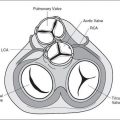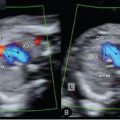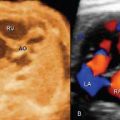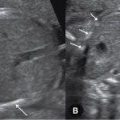PULMONARY ATRESIA WITH
VENTRICULAR SEPTAL DEFECT,
AND ABSENT PULMONARY
VALVE SYNDROME
 TETRALOGY OF FALLOT
TETRALOGY OF FALLOT
Definition, Spectrum of Disease, and Incidence
Tetralogy of Fallot (TOF) is characterized by a subaortic (malaligned) ventricular septal defect (VSD), an aortic root that overrides the VSD, and infundibular pulmonary stenosis (Fig. 17-1). Right ventricular hypertrophy, which represents the fourth anatomic feature of the “tetralogy,” is typically not present prenatally. The spectrum of TOF includes severe forms, such as pulmonary atresia with VSD and absent pulmonary valve, both of which will be discussed in more detail later in this chapter. TOF is one of the most common forms of cyanotic congenital heart disease (CHD) and is found in about 1 in 3600 live births and accounts for 3% to 7% of infants with CHD (1). The classic form of TOF with pulmonary stenosis accounts for about 80% of all newborns with TOF (2).
Ultrasound Findings
Gray Scale
In TOF the four-chamber view appears normal unless the VSD is large and visible in this plane. TOF is typically detected in the five-chamber view, which demonstrates a perimembranous subaortic VSD with an aortic root override (Fig. 17-2). This aortic override is due to a discontinuity between the interventricular septum and the medial aortic wall, with a partial connection of the aorta to the right ventricle. The aorta is thus slightly shifted to the right, a condition termed aortic dextroposition. Generally the aortic root, which receives blood from both the right and left ventricles, appears dilated, especially in the third trimester, which may provide the first hint to the presence of TOF. Furthermore, in TOF, the overriding aorta

Figure 17-1. Tetralogy of Fallot. RA, right atrium; RV, right ventricle; LA, left atrium; LV, left ventricle; Ao, aorta.
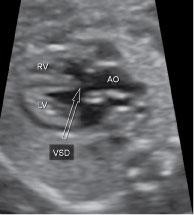
Figure 17-2. Transverse plane of the fetal chest at the level of the five-chamber view showing the ventricular septal defect (VSD) (arrow) and the dilated overriding aorta (AO). LV, left ventricle; RV, right ventricle.
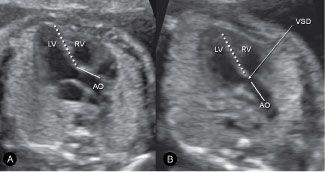
Figure 17-3. Comparison of the apical five-chamber view in a normal fetus (A) and a fetus with tetralogy of Fallot with aortic override (B). In the normal fetus (A), the ascending aorta (AO) points to the right fetal shoulder with a wide angle between the direction of the ventricular septum (dashed line) and the anterior wall of the ascending aorta (solid line) (see also Fig. 6-4). In the fetus with aortic override (B), the course of the ascending aorta (solid line) is parallel to the ventricular septum (dashed line). This finding is also noted in other anomalies involving aortic override. RV, right ventricle; LV, left ventricle; VSD, ventricular septal defect.
Stay updated, free articles. Join our Telegram channel

Full access? Get Clinical Tree


